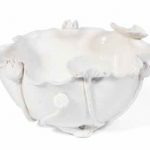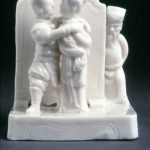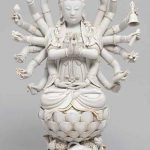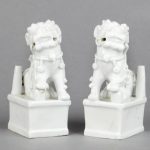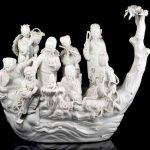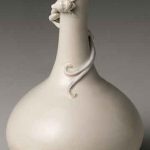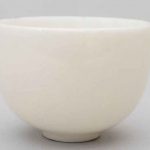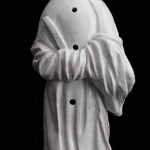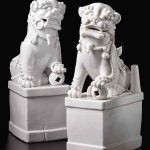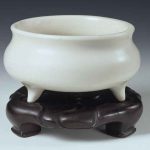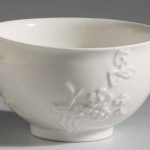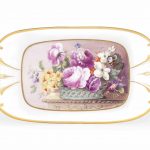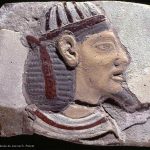Blanc-de-chine is a French term generally used to refer to undecorated ivory white porcelain pieces made for export by the Dehua kilns in the Fujian province, during the 17th-18th centuries. Many early European porcelain factories copied the style. Blanc de Chine wares are covered with a clear glaze which seamlessly seems to adhere to the porcelain body. Reference: Gotheburg.com
A blanc-de-chine ‘lotus leaf’ vessel 18th century The deep bowl formed as a wide lotus pad curled up at the edges, the foot formed from tendrils issuing further smaller pads and flower heads. 21cm (8 1/4in) wide
Sold for £ 2,550 inc. premium at Bonhams in 2019
Figure (group). Made of Blanc de Chine porcelain. Culture/period Qing dynasty Date 1651-1700 (circa)
Reference: © The Trustees of the British Museum
A DEHUA BLANC-DE-CHINE FIGURE OF GUANYIN QING DYNASTY (1644-1911) The eighteen-armed bodhisattva is cast seated on a lotus throne in dhyanasana with a pair of hands held in front of the chest and another on the lap. The other fourteen hands hold attributes and are fanned to the sides. The figure wears loose flowing robes and an elaborate headdress featuring Amitabha. The face bears a serene expression with downcast eyes. There is an impressed seal mark reading bo ji yu ren to the upper back. 18 1/8 in. (46 cm.) high
Sold for GBP 15,000 at Christies in 2019
Pair of Chinese Blanc-de-Chine Porcelain Figures of Foo Lions Height 5 1/2 inches.
Sold for $288 (includes buyer’s premium) at Doyle New York in 2012
A Blanc-de-Chine porcelain group depicting the Daoist immortals of a raft China, early 20th century (35×25 cm.)
Sold for €500 at Il Ponte casa d’aste in 2019
Bottle with Coiling Dragon,late 16th century China Archaeological evidence indicates that the kilns near Dehua in Fujian Province on China’s southeastern coast opened in the late thirteenth century and flourished from the sixteenth to the eighteenth. Characterized by thick, lustrous glazes, Dehua wares, both religious figures and items for use on a scholar’s desk, were exported to Europe in the seventeenth to nineteenth century. They are often known in Western writings by the French term blanc de chine, or “China white,” which originated in nineteenth-century scholarship.
Reference: The Metropolitan Museum of Art
Wine cup, porcelain, blanc de Chine, Qing dynasty, 1723-1735 Blanc de Chine porcelain wine cup with a semi spherical shape on a short foot.
Reference: Museum of Applied Art and Sciences
Figure of a Chinese Man Figure of a Chinaman Austrian (Vienna) about 1725 Attributed to Du Paquier Factory, Vienna (1718–1744)
Chinese figure in long robes, holding a sword, and standing on a wave-molded base. He is pierced with fiveholes to serve as an incense burner. This extremely rare figure clad in flowing robes and standing on a stylized cloud was based on Chinese models. In fact, for many years this was thought to be Chinese, not Austrian, porcelain. Originally, figures like this may have been placed above burning incense or charcoal so that smoke emerging from large holes in the back would create an exotic, theatrical effect.
Reference: Museum of Fine Arts Boston
A pair of Chinese ‘blanc-de-chine’ ‘Buddhist lion’ joss stick holders Qing dynasty, Kangxi period each modeled with one paw resting on a pierced brocade-patterned ball above rectangular bases height 10 1/2 in.; 26.7 cm
Sold for 6,875 USD at Sothebys in 2018
Dehua tripod incense burner of porcelain, with wooden stand
This incense burner was made in kilns at Dehua, in the south-eastern coastal province of Fujian. Dehua porcelain is creamy-white, hard and very translucent. It was known in Europe as ‘Blanc de Chine’.
Reference: © Victoria and Albert Museum
Although long-known in China, the technique of making true or hard-paste porcelain was not rediscovered in Europe until J. F. Böttger’s experiments at Meissen in the early 18th century. This little porcelain cup with its applied prunus or plum blossom decoration reflects the influence of a Chinese, “blanc de chine” porcelain prototype.
Reference: The Walters Art Museum
